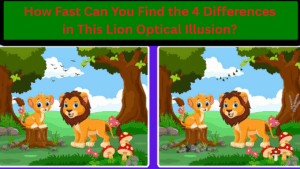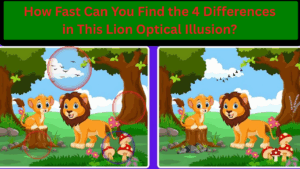
Optical illusions have long captivated our minds, pushing the boundaries of perception and challenging our cognitive abilities. Among the latest viral puzzles sweeping the internet is a particularly intriguing one: an optical illusion featuring a lion that hides four subtle differences between two seemingly identical images. The challenge? Spot all four differences in just four seconds—a feat said to be achievable only by those with exceptional intelligence and a keen eye. In this 1509-word article, we’ll dive into the world of optical illusions, explore the intricacies of the lion difference puzzle, and uncover the science behind why some people can master this challenge while others struggle. Whether you’re a puzzle aficionado or a curious beginner, this article will guide you through the thrill of the hunt and offer tips to sharpen your skills.
Understanding Optical Illusions
Optical illusions are visual phenomena that trick the brain into perceiving something that isn’t entirely accurate. They exploit the complex interplay between our eyes and brain, revealing how our visual system interprets light, color, shape, and perspective. Illusions come in many forms, from ambiguous figures that shift meaning to distortions that warp reality. The lion optical illusion belongs to a popular subtype known as “spot the difference” puzzles, where two images appear identical at first glance but contain subtle discrepancies.

In this particular challenge, the image of a majestic lion—perhaps standing proudly in a savanna or gazing intensely at the viewer—contains four hidden differences. These differences could involve changes in color, missing elements, altered shapes, or shifted positions. The four-second time limit adds an extra layer of difficulty, testing not only visual acuity but also rapid cognitive processing, attention to detail, and mental agility. The claim that only those with a “genius IQ” can succeed in this timeframe has fueled its viral spread, making it a must-try for anyone eager to test their mental prowess.
Why Is the Lion Illusion So Challenging?
The lion optical illusion is designed to deceive even the sharpest observers. Several factors contribute to its difficulty:
-
Visual Similarity: The two lion images are nearly identical, with differences so subtle that they blend seamlessly into the overall scene. For example, a slight change in the lion’s mane or a missing blade of grass might go unnoticed under time pressure.
-
Complex Imagery: Lions are visually intricate creatures, with detailed fur patterns, expressive faces, and dynamic poses. This complexity provides ample opportunity to hide differences, as the brain struggles to process every detail in just four seconds.
-
Time Constraint: The four-second limit forces the brain to work at lightning speed, leaving little room for methodical analysis. This tests instinctive pattern recognition and the ability to prioritize relevant visual cues.
-
Cognitive Overload: The brain must compare two images simultaneously, holding one in working memory while scanning the other for discrepancies. This dual-task processing can overwhelm even experienced puzzle solvers.
-
Perceptual Tricks: The illusion may use techniques like color blending, alignment shifts, or symmetry to mask differences, exploiting the brain’s tendency to “fill in” missing information based on expectations.
The Cognitive Science Behind Spotting Differences
Spotting the four differences in the lion illusion requires a blend of cognitive skills, each playing a critical role in the process:
-
Visual Perception: The eyes must detect minute variations in the image, such as a slightly different shade of fur or a misaligned whisker. While good eyesight helps, the brain’s interpretation of visual data is equally crucial.
-
Selective Attention: With only four seconds to work with, the brain must filter out irrelevant details (e.g., the lion’s background) and focus on areas likely to contain differences. Strong selective attention allows solvers to ignore distractions and hone in on discrepancies.
-
Working Memory: Comparing two images requires holding details of one image in mind while examining the other. A robust working memory enables faster and more accurate comparisons.
-
Pattern Recognition: Humans are wired to detect patterns, a skill honed through evolution for survival. In this illusion, those who can quickly identify deviations from expected patterns (e.g., an irregular ear shape) have an advantage.
-
Processing Speed: The time limit demands rapid cognitive processing, a trait often linked to higher IQ scores. Faster processing allows solvers to scan more of the image in the allotted time.
Does IQ Determine Success?
The notion that only those with a “genius IQ” can spot all four differences in four seconds is a compelling hook, but is it accurate? IQ, or Intelligence Quotient, measures cognitive abilities like reasoning, problem-solving, and spatial awareness, which are relevant to this challenge. Studies suggest that individuals with higher IQs may excel at tasks requiring rapid processing and attention control, giving them an edge in time-sensitive puzzles like this one.
However, IQ is not the sole factor. Other elements, such as experience with similar puzzles, visual training, and even emotional state, can influence performance. For instance:
-
Practice: Regular exposure to spot-the-difference puzzles can train the brain to detect anomalies more quickly.
-
Strategy: Experienced solvers may use systematic scanning techniques, such as dividing the image into quadrants, to maximize efficiency.
-
Calmness: Anxiety under time pressure can impair performance, while a relaxed mindset enhances focus.
While a high IQ may help, anyone can improve their ability to solve the lion illusion with practice and the right approach. The “genius” label is more of a motivational challenge than a strict requirement.
Tips to Master the Lion Illusion
If you’re eager to tackle the lion optical illusion, here are some strategies to boost your chances of spotting all four differences in four seconds:
-
Divide and Conquer: Mentally split the image into sections (e.g., the lion’s head, body, and background) and scan each area systematically. This prevents you from overlooking key regions.
-
Focus on Edges: Differences often appear at the boundaries of objects, such as the lion’s outline or where its fur meets the background. Pay close attention to edges and contours.
-
Look for Asymmetry: If the lion’s face or body appears symmetrical, check for deviations, such as one ear being slightly larger or a whisker missing on one side.
-
Spot Color Changes: Subtle shifts in hue or brightness (e.g., a patch of fur that’s lighter in one image) can reveal differences. Train your eye to notice these variations.
-
Practice Under Pressure: Simulate the four-second limit by timing yourself with other spot-the-difference puzzles. This builds speed and confidence.
-
Stay Relaxed: Panic can cloud your focus. Take a deep breath, trust your instincts, and let your brain do the work.
The Psychology of Viral Puzzles

The lion optical illusion’s viral popularity stems from its blend of challenge, competition, and self-discovery. Platforms like X amplify its reach, with users sharing their attempts, celebrating successes, and debating strategies. The four-second time limit and “genius” claim tap into our desire to prove our intelligence and stand out in a crowd.
Psychologically, solving the puzzle triggers a dopamine rush, rewarding the brain for its effort. The time pressure adds an adrenaline-fueled thrill, making the experience addictive. Social media further fuels engagement by fostering a sense of community, as users compare results and cheer each other on. The lion illusion isn’t just a puzzle—it’s a cultural phenomenon that reflects our love for mental challenges and social connection.
Are You Ready to Roar?
Can you spot all four differences in the lion optical illusion in just four seconds? Whether you succeed on your first try or need a few attempts, the challenge is a fun way to flex your cognitive muscles and explore the quirks of perception. The lion’s majestic image may hide its secrets well, but with practice and strategy, you can uncover them all.
To try the illusion, search for it online or on X, where users are sharing versions of the puzzle along with tips and reactions. Set a timer for four seconds, sharpen your focus, and dive into the hunt. If you don’t find all the differences right away, don’t worry—optical illusions are designed to challenge even the sharpest minds.
In Summary
The lion optical illusion is a captivating test of perception, attention, and speed, wrapped in the allure of a viral challenge. By hiding four subtle differences in a striking image, it pushes our cognitive limits and invites us to explore the fascinating world of visual processing. While a high IQ may offer an advantage, anyone can master the puzzle with practice, strategy, and a keen eye. So, grab a timer, face the lion, and see if you can claim victory in just four seconds. Are you ready to roar?
